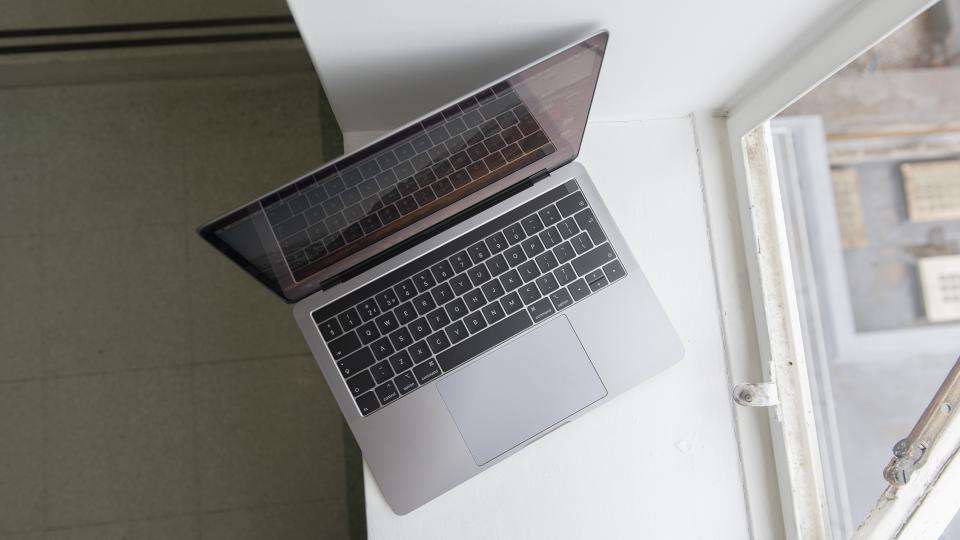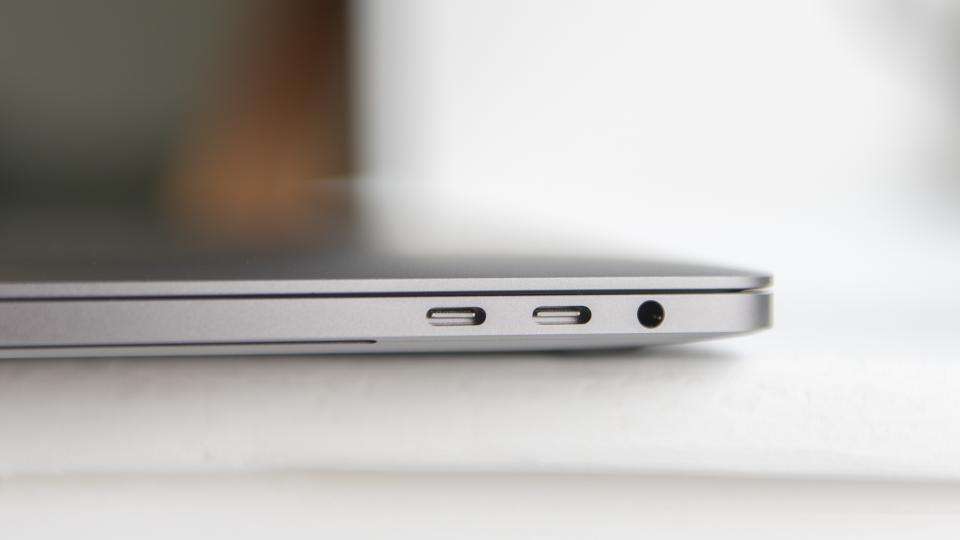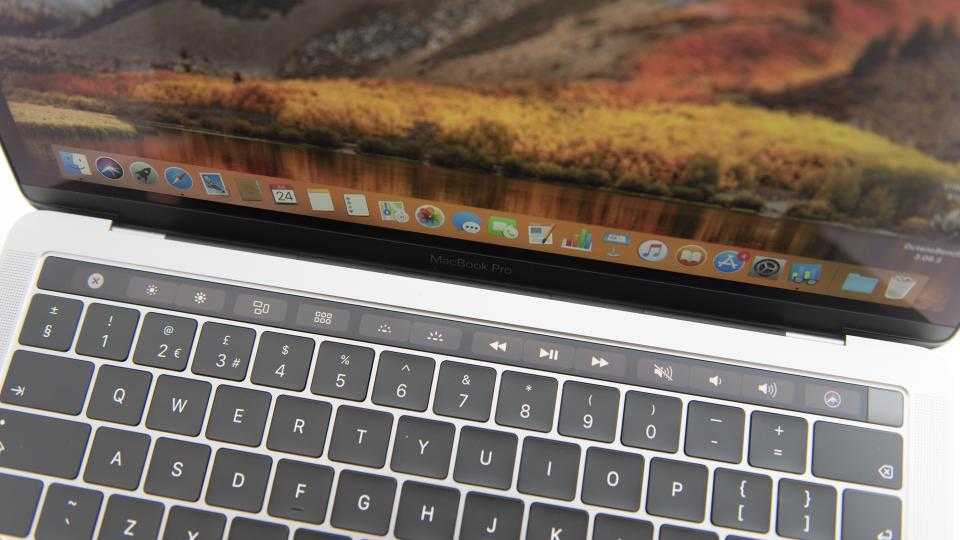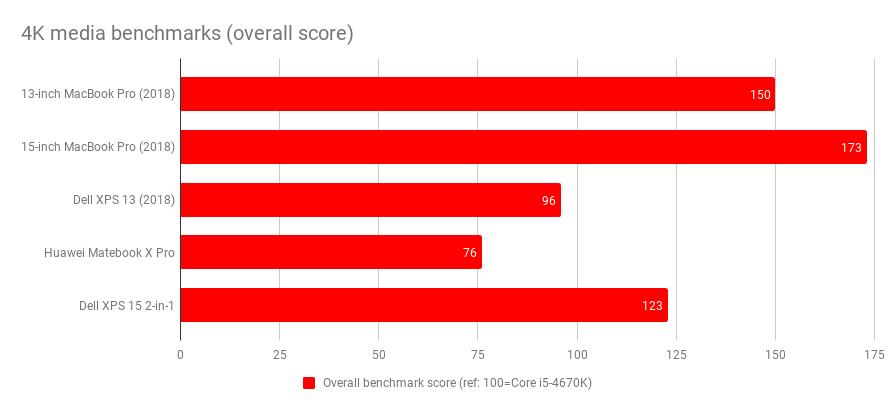The gap between premium Windows portables and the MacBook Pro has been closing in recent times, but Apple’s premium laptop range remains the pinnacle of laptop design. That’s why, presumably, Apple was reluctant to change it dramatically last year and why it stays the same in 2018. Having fallen upon a design that’s still superior to most of its rivals, Apple has been content to improve things gradually.
And so 2018’s 13-inch Apple MacBook Pro is exactly the same size and shape as 2017’s MacBook Pro, has most of the same features, and it’s available in the same colours, too. Only a few important things have changed.
READ NEXT: Our pick of the best laptops you can buy today
13-inch Apple MacBook Pro (2018) review: What you need to know
As ever, Apple has improved the internal specification slightly in this year’s 13-inch MacBook Pro, moving from seventh-gen Kaby Lake to Intel’s eighth-gen Coffee Lake CPUs and offering a 2TB SSD option instead of topping out at 1TB.
However, it has also made a few key design alterations. On the display front, Apple has added True Tone to its Retina-class 13.3in IPS panel. This means the laptop can sense the colour temperature of the light in the room you’re in and match the screen’s white point to it, giving your eyes a break from having to readjust every time you look away from and back to it.
The MacBook Pro’s infamous butterfly-switch keyboard has been given a mild overhaul to make it both quieter and more reliable. And battery capacity gets a small improvement as well.
One thing that hasn’t changed, though, is the non-Touch Bar 13in MacBook Pro. That’s still available with seventh-generation Intel Kaby Lake CPUs, and prices start at £1,249.
Buy now from John Lewis
13-inch Apple MacBook Pro (2018) review: Price and competition
The model Apple sent to us for this review is the very highest specification available and, as such, it’s expensive: £3,599 expensive, in fact. As with the 15-inch MacBook Pro, though, a large chunk of that price goes on the 2TB SSD, which is a £1,400 upgrade on the standard 256GB drive.
With the standard SSD in place and half the RAM (8GB), the price of a 2.7GHz quad-core Core i7 MacBook Pro drops to a more reasonable £2,019, while the cheapest Touch Bar MacBook Pro 13in costs £1,749. I’ve highlighted a few key configurations with example prices in the table below:
|
Base specifications per CPU |
Price |
|
2.3GHz quad-core, 8th-gen Intel Core i5-8300H, 8GB RAM, Intel Iris Plus Graphics 655, 256SSD |
£1,749 |
|
2.7GHz quad-core, 8th-gen Intel Core i5-8559U, 8GB RAM, Intel Iris Plus Graphics 655, 256SSD |
£2,019 |
|
Top specification |
|
2.7GHz quad-core, 8th-gen Intel Core i5-8300H, 8GB RAM, Intel Iris Plus Graphics 655, 256SSD |
£3,599 |
|
Upgrades |
Price |
|
2.7GHz quad-core, 8th-gen Intel Core i7-8559U |
£270 |
|
16GB RAM |
£180 |
|
512GB SSD |
£200 |
|
1TB SSD |
£600 |
|
2TB SSD |
£1,400 |
Base specifications per CPU
Price
2.3GHz quad-core, 8th-gen Intel Core i5-8300H, 8GB RAM, Intel Iris Plus Graphics 655, 256SSD
£1,749
2.7GHz quad-core, 8th-gen Intel Core i5-8559U, 8GB RAM, Intel Iris Plus Graphics 655, 256SSD
£2,019
Top specification
2.7GHz quad-core, 8th-gen Intel Core i5-8300H, 8GB RAM, Intel Iris Plus Graphics 655, 256SSD
£3,599
Upgrades
Price
2.7GHz quad-core, 8th-gen Intel Core i7-8559U
£270
16GB RAM
£180
512GB SSD
£200
1TB SSD
£600
2TB SSD
£1,400
That’s still a lot of money, though, and even the lowest-spec £1,749 Touch Bar model looks pricey. For that money, you can pick up our current favourite laptop, the Dell XPS 15 2-in-1 with a Core i5 Kaby Lake G CPU , while the LG Gram – another lightweight 15in laptop – will set you back around £300 less . The specification? An eighth-gen 1.6GHz Core i5 CPU, 8GB of RAM and a 256GB SSD.
However, the 13-inch MacBook Pro’s chief opposition is the Dell XPS 13 – whose highest specification includes a quad-core 1.8GHz Intel Core i7-8550U, a 4K touchscreen, 16GB of RAM and a 1TB SSD – and costs £1,749 . That may sound like much better value than the base Core i7 MacBook Pro, but bear in mind that the Core i5 MacBook actually runs a faster base clock speed and includes superior integrated graphics.
Apple MacBook Pro 13in (2018) review: Design
As I said above, there’s nothing new about the look and the feel of the new MacBook. The MacBook Pro 13 remains a gloriously desirable machine. Its solid machined aluminium chassis, clean lines and minimalist looks strike all the right notes. This is still the benchmark for laptops when it comes to pure aesthetics and build quality. I prefer the 14in Huawei MateBook X Pro – it has a better screen-to-body ratio than the MacBook and discrete graphics, but the MacBook Pro is clearly the better-made machine.
And, as it has done for some years now, the 13-inch MacBook Pro marries good looks with a good dose of practicality. The Touch Bar machines have four USB Type-C Thunderbolt 3 ports – a pair on each side – allowing the connection of everything from multiple 4K monitors to external graphics boxes like the BlackMagic Designs eGPU . And though it’s a slight annoyance that there’s no SD card reader or USB Type-A port, the huge flexibility and bandwidth of the Thunderbolt 3 USB Type-C connections more than makes up for this.

The only change when it comes to the design is one you can’t see. The butterfly-switch keyboard, which has proved to be a bit of a Marmite feature since its introduction, has been improved, with a thin rubber membrane added between the keytops and its aluminium base. This has two effects. First, it makes the keyboard much quieter and, oddly, it imparts a slightly softer, more finger-friendly feel, too.
Buy now from John Lewis
It also, at least according to the guys over at iFixit, helps prevent dust and grit getting under the keys and stopping them from working, something users have been complaining has been a problem with previous models for some time now.
Elsewhere, I also feel the need to underline that the MacBook Pro’s webcam is still the best in the business, a feature many other manufacturers simply ignore. Although not as much of a talking point as the MateBook X Pro’s keyboard-embedded, pop-up webcam, it produces far cleaner, crisper and less noisy images and that’s what’s important when you’re dropping into a remote meeting or conducting an important business video call.

13-inch MacBook Pro (2018) review: Display
After the keyboard, Apple’s next “big” improvement is the addition of True Tone to the display, which works just as well as it does on Apple’s iPad Pro tablets, giving your eyes a break from having to readjust every time you look away from the screen.
It’s not intended for use in colour-critical workflows, though, and Apple recommends professional creatives turn the feature off. With that in mind, I’d like to have seen an easier way to toggle the feature on and off; as it stands, you have to delve into System Preferences to disable it, which is a pain.

Otherwise, though, the display is excellent. Apple has proved it knows how to produce a good-quality laptop screen over the years and this one is no exception. It measures 13.3in across the diagonal and resolution is a “Retina-class” 2,560 x 1,600 native. In other words, it’s as sharp as the eye can see and you won’t be able to see any pixels unless you press your nose right up against it.
And, technically, it’s beyond reproach. Brightness peaks at a ludicrous 502cd/m2 – bang on Apple’s claims and bright enough to blind you in any indoor lighting – the contrast ratio is 1,451:1, which is, again, fabulous. The screen covers an impressive 99% of the DCI-P3 colour gamut, which is what Apple’s factory calibration targets these days.
13-inch MacBook Pro (2018) review: Performance
With one of Intel’s latest eighth-gen Core i7 CPUs inside, you’d expect performance to be good, too, but the Core i7-8559U in this MacBook is just a little bit special. With a base clock of 2.7GHz and a max Turbo Boost clock of 4.5GHz, plus double the amount of eDRAM at 128GB than last year’s Core i7 MacBook Pro, performance is spectacularly good compared with most of the opposition. The Dell XPS 13 (2018) and Huawei MateBook X Pro are both based on the considerably less beefy 1.8GHz quad-core Intel Core i7-8550U.
Buy now from John Lewis
In our 4K media and multitasking test, it outstripped these two rivals by a huge margin and beat the Dell XPS 2-in-1 (Core i5, Kaby Lake G) to the punch as well.

Storage performance from the 2TB SSD installed in my review device was exceptional as well, reaching consistent speeds of 2.6GB/sec and 2.6GB/sec for sequential reads and writes using the BlackMagic Disk Speed Test app, beating its rivals for consistency once again.
There’s no discrete graphics here as in the Huawei MateBook Pro – only Intel’s integrated Iris Plus 655 – but, as you can see, the frame rates reported in the GFXBench Manhattan test lag only slightly behind those of the 15-inch MacBook Pro and the Huawei MateBook X Pro:
Finally, battery life is staunchly solid, too. With only a small boost to capacity, the 2018 MacBook Pro gained a whole hour’s worth of longevity in our video-rundown test (with the screen set to a calibrated brightness of 170cd/m2 and flight mode engaged). This is truly one great all-rounder of a laptop. The only key rival with better battery life is the Dell XPS 13 but, once again, that’s a much less powerful machine.
Apple MacBook Pro review: Verdict
The big question is, though, should you buy a 2018 13-inch MacBook Pro? At first glance, the answer might be no. Its competitors are notably cheaper, are almost as nicely designed, and have comparable or better battery life.
The Dell XPS 13 , in particular, stands out as providing a fantastic combination of light weight, great design and decent performance. And I do prefer the Huawei MateBook X Pro’s larger screen and more traditional-style keyboard, despite Apple’s improvements on this front.
If it’s sheer grunt you want in a 13-inch laptop, however, the MacBook Pro is hard to match. It’s hugely fast in its Core i7 guise and can be configured to a degree that simply can’t be achieved with a Dell XPS 13. Combine that with Apple’s traditional strengths – a great screen and fabulous build quality – and you have a laptop that’s well worth considering alongside the best the Windows fraternity has to offer.
